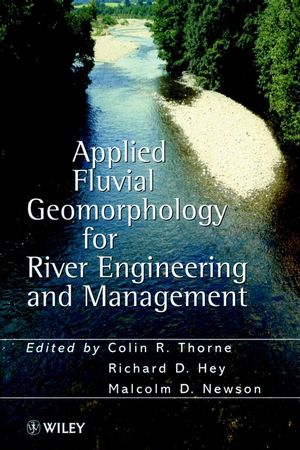Applied Fluvial Geomorphology for River Engineering and ManagementISBN: 978-0-471-96968-6
Paperback
388 pages
June 1998
 This is a Print-on-Demand title. It will be printed specifically to fill your order. Please allow an additional 10-15 days delivery time. The book is not returnable.
|
||||||
This invaluable overview of fluvial geomorphology provides riverengineers and managers, who may lack specialist training, withuseful insights into, and understanding of, natural channel formsand fluvial processes.
Such information is a pre-requisite for carrying out environmentalimpact assessments and for developing environmentally sensitivedesign and management procedures to preserve riverine environmentsand restore degraded ones. Designing with nature is preferable toimposing hard engineering solutions as it sustains naturalbiodiversity and minimises costs. This book will also be a veryuseful teaching aid for students, both under- and post-graduate,studying civil engineering, environmental management or sciences,or geography who are looking to have a wider knowledge of newapproaches to the subject.
Geomorphology requires the collection and consideration of a widerange of data, mostly field based but also including historicalinformation such as archive documents and maps, which are outsidethe experience of most river engineers and managers. These dataenable the current condition of the river to be explained, bothlocally and within the catchment, and establish historical changesand future trends. In addition, process studies have now identifiedmany of the mechanisms controlling river moprhology which underpinthe development of soft, bio-engineering, design procedures. Thebook incorporates material on methods and techniques of datacollection, analysis and interpretation, making extensive use ofcase studies throughout.
Thus the experienced authors go some way towards demystifyingapplied fluvial geomorphology by demonstrating that, while there isstill an element of judgement, major contributions to geomorphicunderstanding usually come from the careful assemblage andobjective analysis of all available data and information.
Such information is a pre-requisite for carrying out environmentalimpact assessments and for developing environmentally sensitivedesign and management procedures to preserve riverine environmentsand restore degraded ones. Designing with nature is preferable toimposing hard engineering solutions as it sustains naturalbiodiversity and minimises costs. This book will also be a veryuseful teaching aid for students, both under- and post-graduate,studying civil engineering, environmental management or sciences,or geography who are looking to have a wider knowledge of newapproaches to the subject.
Geomorphology requires the collection and consideration of a widerange of data, mostly field based but also including historicalinformation such as archive documents and maps, which are outsidethe experience of most river engineers and managers. These dataenable the current condition of the river to be explained, bothlocally and within the catchment, and establish historical changesand future trends. In addition, process studies have now identifiedmany of the mechanisms controlling river moprhology which underpinthe development of soft, bio-engineering, design procedures. Thebook incorporates material on methods and techniques of datacollection, analysis and interpretation, making extensive use ofcase studies throughout.
Thus the experienced authors go some way towards demystifyingapplied fluvial geomorphology by demonstrating that, while there isstill an element of judgement, major contributions to geomorphicunderstanding usually come from the careful assemblage andobjective analysis of all available data and information.



